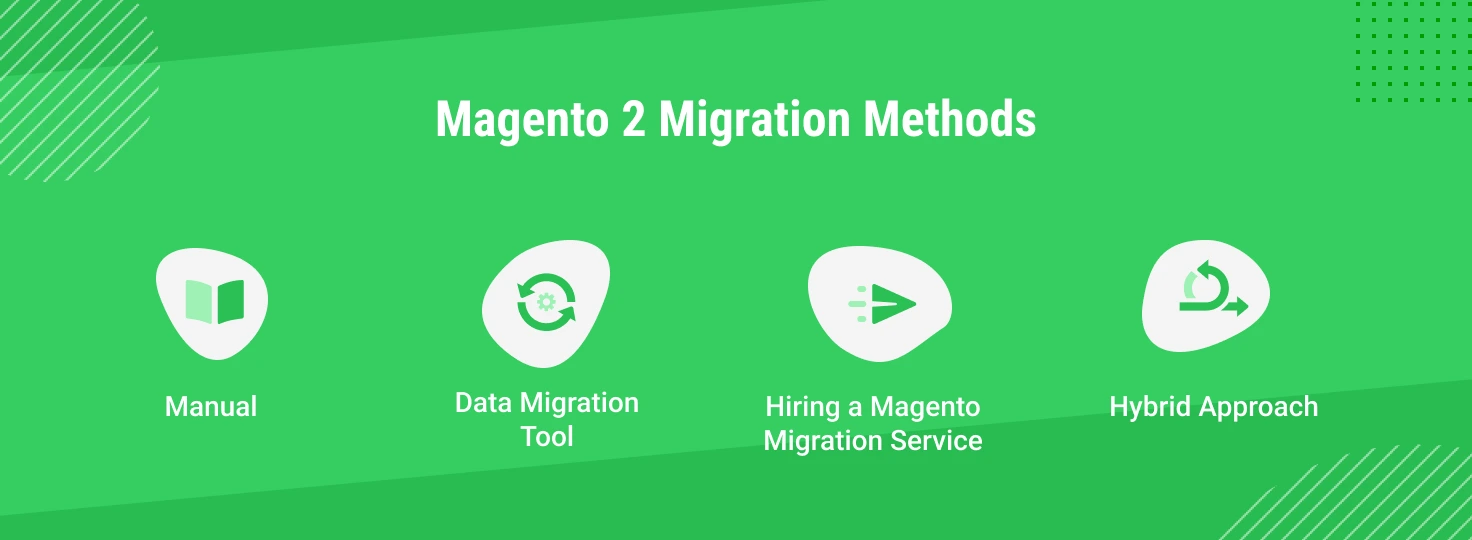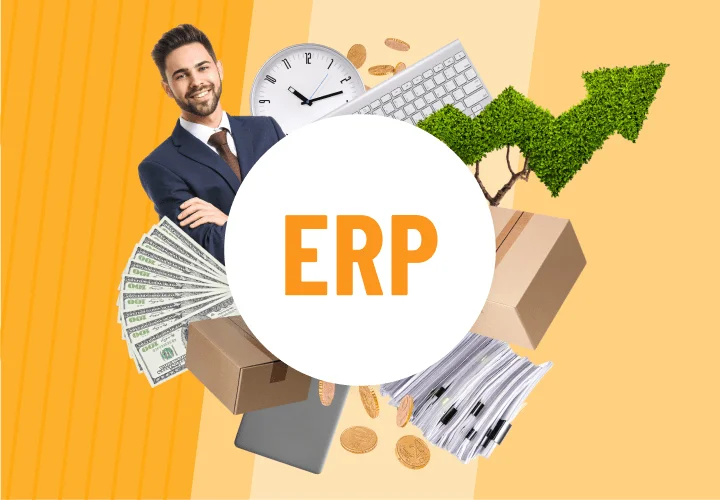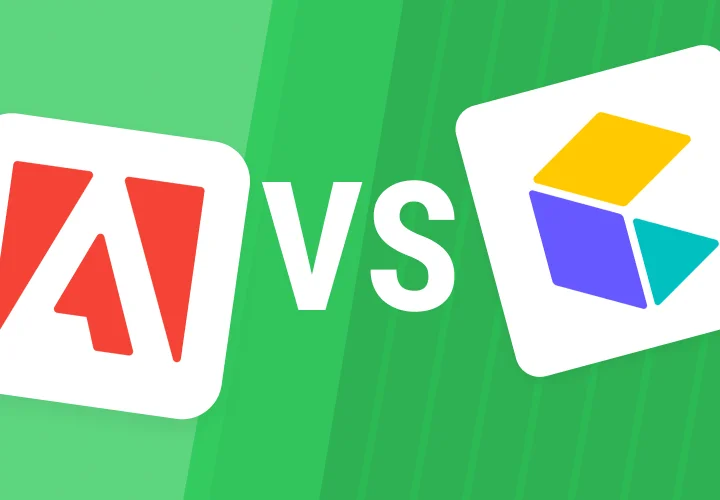Magento 1 to Magento 2 Migration Cost: A Comprehensive Guide
Table of contents
- Key Reasons for Magento Migration
- Challenges to address proactively
- Focusing on ROI and long-term value
- Possible Methods for Magento 2 Migration
- Manual migration
- Using Magento’s data migration tool
- Hybrid approach
- Hiring a Magento migration service
- Components of Magento 1 to Magento 2 Migration
- Theme migration
- Custom function migration
- Extension migration
- Data migration
- Settings migration
- Magento licensing
- Additional costs
- Magento 1 to Magento 2 Migration Timeline
- Hidden Costs to Watch Out for During Magento 1 to Magento 2 Migration
- Reviews
- 10 Factors That Influence Magento Migration Costs
- Types of Magento Migration Services
- Full-service migration
- Custom migration solutions
- Migration in Action: Real-World Magento 2 Transformation Stories
- Migration for growth & reduced TCO in niche retail
- B2B digital transformation for a regional distributor
Enterprise marketplace re-platforming & headless commerce enablement- Conclusion
Magento has long stood as a leading E-commerce platform, trusted by businesses worldwide for its flexibility and scalability. As of December 2024, over 661,000 websites rely on Magento, with Magento 2 powering more than 203,000 of them. Despite Magento 1 reaching its end-of-life in June 2020, many businesses, particularly small to mid-sized enterprises, continue to operate on outdated infrastructure, exposing themselves to security vulnerabilities, performance issues, and limited growth potential.
In the United States alone, over 42,000 websites still run on Magento, underscoring both the platform's popularity and the urgency of migration for many organizations. Notably, Magento 2 adoption continues to rise, with over 39,000 websites now using the latest Magento 2.4 version, reflecting a growing recognition of the platform's enhanced capabilities.
For businesses still on Magento 1, transitioning to Magento 2 is no longer a matter of if but when. The migration is not merely a technical upgrade; it's a strategic move to ensure compliance, improve customer experience, and unlock the performance advantages of a modern, future-ready platform.
While there is no one-size-fits-all price tag for Magento migration, this article offers a practical breakdown of key cost drivers and estimated ranges. Whether you're considering a minimal migration or a full-scale E-commerce overhaul, this guide will help you understand what influences the cost and how to plan effectively.
If you're looking for assistance in setting up your online business, Emerline experts have got you covered. With over 12 years of experience in the market and with E-commerce development services, we are ready to assist you with a seamless Magento 1 to 2 migration and custom Magento development services.
Key Reasons for Magento Migration
The migration from Magento 1 to Magento 2 is not merely a technical upgrade. It's a strategic business decision, especially in light of Adobe's significant shift in its commerce offerings. Starting June 2025, Adobe Commerce is officially transitioning to a cloud-native model, fundamentally reshaping the landscape for merchants and developers alike. On-premises deployments and traditional managed services are being phased out in favor of three distinct cloud-based solutions:
- Adobe Commerce as a Service (SaaS): Designed for simplicity, this model offers automated updates, security, and infrastructure management, making it ideal for businesses seeking operational efficiency and lower maintenance overhead.
- Adobe Commerce on Cloud (PaaS): A robust, customizable platform offering deeper control and flexibility for businesses with complex needs or industry-specific requirements.
- Adobe Commerce Optimizer: A headless, composable architecture that supports modular development and seamless integration with external systems, allowing futureproof scalability and agility.
This is not just a pricing revision; it's a transformative update that directly affects long-term planning, customization capabilities, and hosting strategy. Businesses continuing on Magento 1 or legacy Magento 2 implementations must reassess their approach to remain competitive, secure, and scalable in this new environment.
It's essential to understand that Magento migration is more than a data transfer — it's a move to a new platform that requires rebuilding. While product data, customer profiles, and order histories can often be carried over, the architecture, extensions, themes, and custom features need significant redevelopment. This shift repositions the migration as an opportunity to:
- resolve technical debt accumulated in Magento 1
- rebuild with cleaner, more efficient architecture
- improve performance and prepare for scaling
Framing migration as a strategic re-platforming effort helps manage expectations and justifies the associated costs, setting the stage for long-term return on investment.
Challenges to address proactively
Emerline approaches every migration with a deep understanding of the risks and complexities involved. Key issues we help mitigate include:
- Data integrity and customization conflicts: Magento 1 and 2 differ structurally, requiring tailored development to preserve key business processes or rethink outdated ones.
- Plugin and theme incompatibility: Magento 1 extensions and themes are not directly compatible with Magento 2. Rebuilding or finding equivalent solutions is essential.
- Limited Magento 2 expertise: The relative scarcity of experienced Magento 2 developers often leads to delays and increased costs. Emerline mitigates this through a seasoned development team and efficient delivery models.
- Business disruptions: Migration must be carefully managed to avoid downtime in order processing, inventory updates, or customer service workflows. Our team plans for smooth rollouts and phased transitions.
- SEO and organic traffic risks: Poorly managed migrations can lead to significant ranking losses. Emerline ensures proper 301 redirects, metadata preservation, and post-migration SEO audits.
- Performance optimization post-migration: Launch is only the beginning. We fine-tune Magento 2 instances for server efficiency, caching, mobile responsiveness, and page speed.
Focusing on ROI and long-term value
Beyond immediate improvements, Magento 2 offers substantial long-term business value. Migration often leads to:
- Performance gains: Faster load times, improved admin UI, and increased order throughput.
- Stronger security: Magento 2's modern security architecture reduces the risk of breaches.
- Operational efficiency: Streamlined backend workflows and better integration with ERP, CRM, and third-party services.
- Scalability for growth: Magento 2 supports expansion into new markets, omnichannel experiences, B2B portals, and marketplace integrations.
- Faster payback: Most businesses see a return on investment in 9–15 months, thanks to higher conversion rates and operational cost savings.
Finally, migrating to Magento 2 or Adobe Commerce isn't just a technical necessity; it's a strategic move toward future-ready E-commerce. With Adobe's 2025 roadmap, businesses gain access to: - Composable commerce capabilities: Through Adobe Commerce Optimizer, you can build modular solutions tailored to changing business needs.
- AI-powered features: Magento 2's native AI functionalities, including personalized recommendations and automated merchandising, enhance customer experience and operational intelligence.
- Robust API ecosystem: Magento 2 offers powerful APIs and ready integrations with leading platforms, enabling agility in a connected digital landscape.
- Enterprise-grade scalability: Support for thousands of SKUs, global shipping logic, and localized experiences make Magento 2 ideal for international growth.
At Emerline, we don't just migrate — we strategize, optimize, and futureproof. Our team ensures that every migration investment supports your business goals, prepares you for Adobe's evolving ecosystem, and unlocks the full potential of modern E-commerce.
"In our Magento 1 to Magento 2 migration projects, clients consistently experience a 20–30% boost in page load speed and a 15–25% uplift in conversion rates following the migration.”- Maksim Paseka, Lead E-сommerce Software Engineer
Possible Methods for Magento 2 Migration
Selecting the right approach is critical when planning a Magento 1 to Magento 2 migration. As with any E-commerce migration, the method depends on several factors: the complexity of your store, the volume of data to be transferred, the extent of customizations, and your available budget and timeline.
Below are the primary migration methods, estimated timeframes, and cost ranges to help you plan strategically.

Manual migration
Manual migration involves rebuilding your Magento 1 store from the ground up on Magento 2. This method gives you complete control over every aspect of your new store and is ideal for highly customized or outdated Magento 1 setups that require significant rethinking.
While labor-intensive, manual migration allows review of outdated features, cleanup of legacy data, and rebuilding of a more optimized store architecture.
- Best for: Full control and heavily customized stores
- Estimated time: 400–700 hours
- Cost range: $20,000–60,000
- Pros: High flexibility, tailored results, a chance to re-architect
- Cons: Time-consuming, resource-intensive
Using Magento’s data migration tool
Magento provides an official Data Migration Tool designed to automate the transfer of core elements such as products, customers, orders, and settings. This faster and more structured approach is best suited for standard Magento 1 stores with minimal customizations.
That said, it requires a good understanding of Magento’s database structure, especially for larger catalogs or migrating extensions.
- Best for: Stores with simple catalogs and minimal customization
- Estimated time: 20–60 hours
- Cost range: $500–2,500
- Pros: Fast, cost-efficient, supported by Adobe
- Cons: Limited customization, potential incompatibility with complex setups
Hybrid approach
The hybrid migration approach blends automation with manual customization. The Magento Data Migration Tool is typically used for core data migration, while themes, extensions, and custom code are handled manually.
This method balances efficiency and control, making it a strong choice for businesses with moderate complexity and customization needs.
- Best for: Mid-size stores with a mix of standard and custom features
- Estimated time: 150–400 hours
- Cost range: $10,000–30,000
- Pros: Balanced workload, cost-effective, adaptable
- Cons: Still requires manual effort and technical oversight
Hiring a Magento migration service
Partnering with a professional Magento migration service provider like Emerline offers the most seamless experience for businesses seeking a hands-off, risk-minimized migration. A dedicated team manages the end-to-end process, including data migration, theme rebuilding, extension mapping, QA, and post-launch support.
This option ensures minimal disruption to daily operations, adherence to best practices, and a migration plan aligned with Adobe’s 2025 roadmap and long-term business goals.
- Best for: Businesses prioritizing reliability, scalability, and strategic planning
- Estimated time & cost: Varies based on complexity
- Pros: Expert execution, reduced risk, full-service support
- Cons: Higher initial cost, but offset by lower risk and better outcomes
Choosing the proper migration method is essential to ensure business continuity, performance, and ROI. Emerline’s team can help you evaluate your current setup, define your strategic priorities, and guide you toward the most effective migration path for your E-commerce future.
Components of Magento 1 to Magento 2 Migration
Regardless of the migration method selected, it's essential to understand the key components that influence the overall cost and effort of transitioning from Magento 1 to Magento 2. Migration is not simply a matter of transferring data; it's a comprehensive rebuild of your E-commerce platform that touches on design, functionality, security, and performance.
Below is a breakdown of the major cost-driving components and considerations to help businesses plan effectively.
Theme migration
Magento 1 themes are incompatible with Magento 2, so businesses must either adopt a ready-made Magento 2 theme or opt for custom theme development. Before proceeding, you must identify which design elements and user interface features you want to retain or improve.
- Ready-made themes: Available on platforms like Magento Marketplace or ThemeForest, priced between $50–$500. Installation and configuration by a developer may add $750–$1,500.
- Custom theme development: Offers complete control over branding, UX, and performance. Development costs typically range from $3,000 to $10,000.
While the custom approach is more resource-intensive, it enables long-term differentiation and optimization.
Custom function migration
If your Magento 1 store includes custom features, bespoke workflows, or unique scripts, these must be rebuilt or reimplemented for Magento 2. Since custom code doesn't carry over, this process involves:
- Evaluating what to keep, replace, or enhance
- Rebuilding modules to meet Magento 2's architectural standards
- Extensive testing to ensure stability and performance
The cost depends on complexity and scope but is generally a significant portion of the migration budget for customized stores.
Extension migration
Magento 1 extensions are not forward-compatible with Magento 2. Most functionalities must be replaced by:
- Equivalent Magento 2 versions (if available)
- New extensions from trusted vendors
- Custom development if equivalents do not exist
- Typical cost per extension: $50–$500
- Installation and configuration: Up to $500 per extension
The final cost depends on the number of extensions, the level of customization, and whether replacements require manual integration or development.
Data migration
Data migration is arguably the most sensitive and critical component of the process. It involves securely transferring:
- Product and category data
- Customer accounts
- Order histories
- Transaction logs and store configurations
Even a minor data loss can impact operations or regulatory compliance. While Adobe provides a Magento Data Migration Tool, its use requires technical expertise, especially in complex scenarios. Partnering with a professional ensures accuracy, completeness, and compliance.
- Typical cost range: $500–$1,000, depending on data volume and structure
- Critical to success: Data validation, backup, and testing protocols
Settings migration
Core configuration settings such as tax rules, shipping methods, payment gateways, store views, user roles, and permissions must be replicated in the Magento 2 environment.
Although these are not difficult to migrate, incorrect setup can lead to functional issues post-launch.
- Estimated cost: $500–$1,000
- Key consideration: Revalidation against new Magento 2 system behavior
Magento licensing
Magento's licensing model has evolved into two distinct paths under the Adobe Commerce brand:
- Magento Open Source: Free to use but requires full responsibility for hosting, setup, security, and extensions. It is ideal for businesses with strong internal technical resources or smaller operations.
- Adobe Commerce (Pro and Managed Services):
- The Pro version includes advanced features like B2B capabilities, business intelligence, and support.
- Managed Services adds cloud infrastructure, auto-scaling, monitoring, and advanced support options.
Licensing costs depend on annual Gross Merchandise Value (GMV) and Average Order Value (AOV) and typically start at several thousand dollars per year, scaling with business size.
To help you evaluate options within the Adobe Commerce suite effectively, we’ve prepared the following comparison table:
|
Feature |
Magento Open Source |
Adobe Commerce |
Adobe Commerce Cloud |
|
Main store management functionality |
✅ |
✅ |
✅ |
|
Website search |
Basic |
Advanced |
Advanced |
|
Product display |
❌ |
✅ |
✅ |
|
Real-time analytics |
Basic |
Performance analytics dashboards and AI-driven recommendations |
Performance analytics dashboards and AI-driven recommendations |
|
Customer classification |
❌ |
✅ |
✅ |
|
Loyalty programs with gift cards |
❌ |
✅ |
✅ |
|
Comprehensive SEO activities (on-site, off-site & technical SEO) |
✅ |
✅ |
✅ |
|
Fast page loading |
❌ |
❌ |
✅ |
|
B2C-adjusted |
✅ |
✅ |
✅ |
|
B2B-adjusted |
❌ |
✅ |
✅ |
|
Hosting availability |
❌ |
❌ |
✅ |
|
Community support |
✅ |
✅ |
✅ |
|
Tech support |
❌ |
✅ |
✅ |
|
Performance monitoring |
❌ |
❌ |
✅ |
|
Security & compliance |
Limited |
Several features |
Enhanced security and compliance, including DDoS services, firewall protection, and PCI compliance |
Additional costs
Migration is also a strategic opportunity to invest in modernizing operations. Businesses should factor in:
- SEO migration (301 redirects, metadata optimization) to retain rankings
- Third-party integrations (ERPs, CRMs, PIMs, payment gateways)
- QA and testing across devices and browsers
- Mobile optimization
- Post-launch support and performance tuning
- Consultation fees for migration experts
These services ensure that the new platform operates at full capacity from day one and supports long-term scalability.
Below is a breakdown of typical cost components involved in the migration process, helping you assess the investment scope and plan strategically.
|
Migration type |
Cost |
|
Initial analysis and planning |
$800 - $1,600 |
|
Magento 2 installation and configuration |
$400 - $1,600 |
|
Theme setup and customization |
$2,250 - $10,000 |
|
Code customization |
$800 - $8,000 |
|
Testing and bug fixing |
$800 - $4,000 |
|
Theme migration |
Cost: $0 - $10,000 Free themes are available |
|
Custom function migration |
Cost: $2,000 - $40,000 Can include overall customization |
|
Extension migration |
$50 - $500 |
|
Data migration |
$500 - $1,000 |
|
Settings migration |
$500 - $1,000 |
|
Magento license |
From a free Magento Open Source version to $40,000 for Adobe Commerce Cloud (see the table above) |
|
Unforeseen work (10-20% of the total cost) |
$850 – $15,500 |
|
TOTAL |
$8,500 – $77,500 |
Understanding these components allows businesses to approach Magento 2 migration not as a one-off project but as a strategic investment in future-proofing their E-commerce operations. Emerline offers tailored consultation and execution support to help businesses plan efficiently, manage risks, and maximize return on investment throughout the migration journey.
Magento 1 to Magento 2 Migration Timeline
The timeline for migrating from Magento 1 to Magento 2 varies significantly depending on your store’s complexity, data volume, and the scope of custom functionality. While some simple migrations can be completed in a few weeks, more sophisticated projects, particularly those involving enterprise-level systems, may require several months.
Several core factors affect the duration of a Magento 2 migration:
- Store size and architecture (number of SKUs, multi-store setup, etc.)
- Custom code and third-party extension dependencies
- Theme complexity and design requirements
- Data quality and volume
- Internal vs. outsourced migration team
Below is a rough breakdown of typical migration timelines based on project complexity:
|
Store Complexity |
Timeline (weeks) |
Effort (hours) |
|
Simple (catalog + blog) |
6–10 |
150–300 |
|
Mid-level (multi-store, 10+ plugins) |
10–16 |
300–500 |
|
Enterprise (custom modules, ERP integration) |
16–28+ |
500–800 |
These estimates include the complete workflow, from initial analysis and planning to post-launch QA and bug fixes. Unexpected challenges (such as plugin incompatibilities or data anomalies) can extend the timeline. A 10–20% extra time buffer is often recommended to account for revisions, testing iterations, or delayed third-party support.
Hidden Costs to Watch Out for During Magento 1 to Magento 2 Migration
While the core components of a Magento 1 to Magento 2 migration are often well planned and budgeted, many businesses overlook certain hidden costs that can significantly impact the final budget and timeline. These hidden expenses often emerge after migration or during internal adaptation to the new platform. Being aware of them in advance enables proactive planning, helping to avoid unpleasant surprises and ensuring a smoother transition. The table below outlines the most common categories of hidden costs, their estimated cost impact, and recommended mitigation strategies.
Reviews
Research the company's reputation by reading reviews and testimonials from previous clients. Previous feedback on their customer support, project management, and technical expertise will give you an insight into their capabilities.
|
Hidden Cost Category |
Description |
Estimated Cost Range |
Mitigation Strategy |
|
Performance Optimization Post-Migration |
Configuring the new Magento 2 platform to achieve optimal speed and stability after launch. |
$1,500 – $5,000 (budget for 1–3 months of work) |
Plan for 1–3 months of post-launch optimization; include server reconfiguration, cache optimization, and extension performance testing in your budget. |
|
Staff Training |
Training employees on the new Magento 2 admin interface and updated workflows. |
Significant (varies based on team size) |
Integrate training into the project scope; create internal manuals and conduct workshops or guided training sessions. |
|
Licensing and Extension Replacement |
Purchasing licenses for Magento 2-compatible extensions, as Magento 1 extensions are not compatible. |
$50 – $1,000+ per extension, up to $2,500 for ERP modules |
Conduct a thorough extension audit pre-migration to eliminate redundant or outdated plugins and determine necessary replacements. |
|
SEO Issues and Traffic Loss |
Costs related to fixing SEO problems, such as incorrect 301 redirects that can lead to a drop in organic traffic. |
40–60% traffic loss without proper redirects |
Develop a detailed SEO migration strategy, including precise URL mapping and 301 redirect configuration. |
|
Emergency Support and Bug Fixes |
Unexpected issues requiring urgent post-launch intervention. |
$150 – $300/hour |
Allocate a contingency budget (10–20% of total effort). Secure a post-migration support agreement. |
|
Future Upgrades and Version Migrations |
Costs associated with major Magento version upgrades (e.g., from 2.4 to 2.5) and ensuring extension compatibility. |
$5,000 – $20,000 per major upgrade; $1,000 – $5,000 for extension updates |
Plan for ongoing upgrades as part of regular maintenance. Choose extensions with strong support and update policies. |
|
Parallel Platform Operation |
Costs of maintaining Magento 1 during the Magento 2 migration phase. |
Significant |
Minimize the parallel operation period through careful planning and coordination. Use tools for data synchronization. |
10 Factors That Influence Magento Migration Costs
Understanding the breakdown of core migration components and hidden expenses is essential, but cost projections can vary widely depending on internal and external factors. These elements influence your financial investment and the project’s complexity, duration, and required resources. Below are the most significant factors that affect the overall cost of Magento 1 to Magento 2 migration:
1. Scope of customization
The more custom logic, features, or storefront elements your Magento 1 store relies on, the more development time and budget will be required to replicate or adapt them in Magento 2. While some native functionality may now be available out-of-the-box in Magento 2, many custom modules will need to be redeveloped from scratch.
2. Number and complexity of extensions
Extensions must be reviewed for compatibility, replaced, or rebuilt. If your store uses numerous third-party plugins or relies heavily on outdated or unsupported ones, migration costs increase proportionally.
3. Theme migration and frontend rework
Magento 1 themes are not transferable to Magento 2. As a result, businesses must decide whether to redesign, rebuild, or adapt the existing UI using a new theme. Choosing a free theme may reduce costs, but custom design or UX improvements can increase the budget.
4. Store size and data volume
A larger catalog, more customers, and extensive historical order data mean more complex and time-consuming data migration. Mapping and testing data accuracy across product attributes, customer groups, and sales records adds to the workload.
5. Store complexity (Multi-store, ERP, APIs)
Multi-store setups, complex backend integrations (e.g., ERP, CRM, PIM), and custom APIs significantly increase migration complexity. These elements require additional development effort and thorough testing to ensure stability.
6. Required performance optimization
Post-migration optimization isn’t just a hidden cost — it’s also a significant cost driver. For optimal performance, server configurations, caching layers, CDN setup, and load balancing must be aligned with Magento 2’s architecture.
7. SEO and URL structure maintenance
Retaining existing SEO value during migration requires careful planning, including setting up redirects, preserving metadata, and avoiding broken links. This requires coordination between developers and SEO specialists.
8. Testing and QA depth
The more comprehensive your testing process (including unit tests, regression testing, and user acceptance testing), the more hours must be allocated, especially for customized builds or high-traffic stores.
9. Internal team involvement and training
If internal stakeholders will be actively involved in testing, approvals, or backend operations, additional time must be set aside for onboarding and coordination. Staff training also becomes crucial post-migration to ensure a smooth transition.
10. Choice of Magento edition (Open Source vs. Commerce)
The edition you migrate to affects licensing fees, features available out of the box, and infrastructure requirements. Magento Commerce (Adobe Commerce) requires a significantly larger investment than Open Source.
Types of Magento Migration Services
Magento 1 to Magento 2 migration services typically fall into two main categories: full-service and custom migration solutions. Each approach offers distinct benefits depending on your store's complexity, available internal resources, and desired level of involvement.
Full-service migration
This comprehensive, end-to-end solution covers every aspect of the migration process. It includes data transfer, theme and extension migration, custom module redevelopment, quality assurance testing, performance optimization, and post-launch support. Full-service migration is ideal for businesses seeking a seamless transition with minimal internal effort, particularly suitable for large, multifaceted E-commerce platforms.
Custom migration solutions
Tailored to businesses with unique structures or highly customized Magento 1 setups, custom migration services focus on specific aspects of the migration process. This may include recreating custom-built functionalities, adapting complex themes, or integrating external systems such as ERPs, CRMs, or payment gateways. Custom migration is best suited for businesses that require a personalized approach and have distinct technical or operational needs.
Migration in Action: Real-World Magento 2 Transformation Stories
Migration for growth & reduced TCO in niche retail
Client profile:
A fast-growing online hobby retailer with annual revenue under $1M. Operated on Magento 1 (CE 1.9.3.x) with moderate customization and performance challenges during traffic spikes.
Initial setup & challenges:
- Complexity level: Low to medium
- Extensions: 7–8 third-party modules (SEO Toolkit, Advanced Caching, Payment Gateway, Google Analytics, etc.)
- Custom code: Light modifications to CSS/JS and 2–3 minor functional changes (e.g., custom product attributes, improved search)
- Key issues: Poor performance during peak traffic; fragmented Magento 1 database due to failed updates
Migration approach: - Strategy: Lift & Shift with optimization. Focused on clean data migration and theme reconstruction on Magento 2’s Luma framework.
- Data migration: Used Magento Data Migration Tool with pre-cleaning and SKU deduplication. Migrated 100% of customer data, order history (~20,000 orders), and catalog (~5,000 SKUs).
- Extension handling: After the audit, we replaced 3 out of 8 extensions with native M2 functionality. Others were either upgraded (M2-compatible versions) or replaced with modern alternatives like ElasticSearch.
- Customization porting: Legacy custom features were reviewed; most were re-implemented using Magento 2 best practices (Service Contracts, Dependency Injection) to improve maintainability.
Solutions to key problems: - Magento 1 performance bottlenecks: These were addressed via a new M2 architecture featuring Varnish, Redis, and CDN. Post-migration, query, and page rendering were optimized.
- Outdated extensions: Critical functionalities were ported using modern extensions or custom modules.
- Data integrity issues: Applied pre-migration scripts for data cleansing and normalization, ensuring clean transfer.
Estimated investment: - Theme migration: $1,500–$3,000
- Custom feature migration: $1,000–$2,500
- Extension handling: $2,000–$4,000
- Data migration: $1,000–$2,000
- Settings migration: $500–$1,000
- Performance optimization: $1,500–$3,000
- Total cost: $7,500–$17,500
Outcomes & ROI: - Performance: LCP improved by 40–50% (from ~3.5s to ~1.8s)
- Conversion rate: Increased by 8% within three months post-launch
- Security & compliance: Achieved PCI DSS compliance and gained access to regular Adobe security updates
- TCO reduction: Maintenance costs decreased by ~15% due to the elimination of outdated tech dependencies
- Scalability: Improved capacity to handle 2–3x higher traffic during peak times
B2B digital transformation for a regional distributor
Client profile:
A mid-sized B2B distributor of industrial components with $10–20M in annual revenue. Ran on Magento 1 (EE 1.14.2.x) with deep ERP and CRM integrations.
Initial setup & challenges:
- Complexity level: High
- Key features: Custom catalogs, tiered order approvals, credit limits, and deep integration with SAP and Salesforce
- Custom modules: 50+ unique modules significantly altering customer management, checkout, and pricing logic
- Challenge: Legacy SOAP-based integration layer caused frequent synchronization failures
Migration approach:
- Strategy: Replatforming focused on M2 Commerce’s native B2B capabilities. Custom features were analyzed and selectively rebuilt.
- Data migration: Used Data Migration Tool and custom scripts for complex data (e.g., company-specific pricing rules). Migrated 500,000+ customers, 100,000+ SKUs, and over 500,000 orders.
- Integrations: We built a modern integration layer using RabbitMQ for asynchronous data exchange and added Mulesoft API Gateway for centralized API management.
- Modules: Where possible, legacy logic was replaced with M2 B2B Suite capabilities; others were rewritten using modern Magento 2 standards.
Solutions to key problems:
- Complex B2B logic: Re-engineered key business logic, such as dynamic credit management, as modular M2 components.
- Integration instability: Switched to event-driven architecture (EDA) using RabbitMQ to reduce integration errors by 90%.
- User onboarding: Provided customized dashboards, training, and documentation to streamline user transition.
Estimated investment:
- Theme migration: $5,000–$12,000
- Custom function migration: $15,000–$40,000
- Extension handling: $5,000–$15,000
- Data migration: $2,000–$5,000
- Settings migration: $1,000–$2,000
- Integrations (SAP/CRM/MQ): $10,000–$30,000
- Total cost: $38,000–$104,000
Outcomes & ROI:
- Efficiency: 25% faster B2B order processing
- Automation: Reduced manual sync operations by 80%
- Customer Experience: Net Promoter Score (NPS) increased by 15 points
- Stability: 90% fewer ERP sync errors
- Scalability: Created a robust, future-proof B2B commerce platform
Enterprise marketplace re-platforming & headless commerce enablement
Client profile:
A high-traffic, multi-vendor marketplace generating over $50M in annual revenue. Required extreme scalability and flexibility.
Initial setup & challenges:
- Complexity level: Very high
- Custom features: Multi-vendor architecture, commission logic, custom payment gateways, vendor/buyer dashboards, real-time chat
- Legacy code: Heavily customized M1 core with tightly coupled modules
- Key challenges: Poor performance, high cost of scaling and support, limited flexibility
Migration approach:
- Strategy: Full re-platforming with Headless Commerce and microservices. Magento 2 (Adobe Commerce) was used for the backend. The front was rebuilt with PWA Studio and React.
- Data migration: Incremental migration of millions of records via custom scripts and Magento’s Data Migration Tool
- Architecture: Migrated to microservices for vendor management, commission handling, and search using AWS Lambda, Azure Functions, and API Gateway
- Frontend: Custom PWA built for lightning-fast mobile-first experience and SEO efficiency
Solutions to key problems:
- Scalability issues: Re-architected system into independently scalable services connected via GraphQL
- Slow UI/UX: PWA-based frontend ensured sub-second LCP and seamless UX
- Downtime risk: Employed a zero-downtime strategy with incremental sync and cut-over switching
- Vendor management complexity: Built a custom vendor management module integrated with CRM for automated onboarding and catalog handling
Estimated investment:
- Headless frontend: $30,000–$80,000+
- Custom microservice architecture: $40,000–$150,000+
- Extension redevelopment/integration: $10,000–$30,000+
- Data migration: $5,000–$15,000+
- Settings migration: $2,000–$5,000
- Infrastructure & DevOps: $10,000–$25,000
- Total cost: $97,000–$305,000+
Outcomes & ROI:
- Performance: Page speed improved by 60–80% (LCP <1s), reducing bounce rates
- Scalability: Handled 5–10x traffic and transaction volume without performance loss
- Conversion rate: Increased by 12–18% due to improved UX
- Time-to-market: 30% reduction in feature rollout time
- Risk reduction: Migrated to a secure, supported, and extensible platform
Conclusion
Magento 1 to Magento 2 migration is not only a necessary step to ensure security and boost performance but also an opportunity to enhance your E-commerce store's capabilities. By understanding the migration components, potential costs, available migration service types and options for migration partners, you'll be better equipped to make informed decisions for a successful migration.
The Emerline team supports you with expert Magento migration services and full-cycle solutions for your E-commerce business to make the upgrade process smooth.
Updated on Jul 4, 2025





